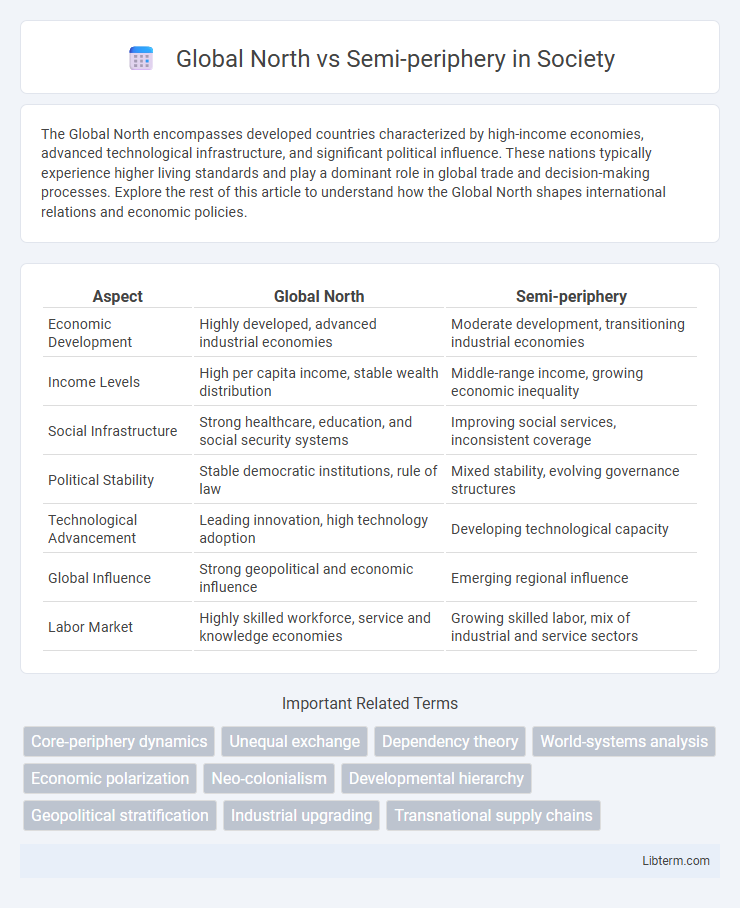The Global North encompasses developed countries characterized by high-income economies, advanced technological infrastructure, and significant political influence. These nations typically experience higher living standards and play a dominant role in global trade and decision-making processes. Explore the rest of this article to understand how the Global North shapes international relations and economic policies.
Table of Comparison
| Aspect | Global North | Semi-periphery |
|---|---|---|
| Economic Development | Highly developed, advanced industrial economies | Moderate development, transitioning industrial economies |
| Income Levels | High per capita income, stable wealth distribution | Middle-range income, growing economic inequality |
| Social Infrastructure | Strong healthcare, education, and social security systems | Improving social services, inconsistent coverage |
| Political Stability | Stable democratic institutions, rule of law | Mixed stability, evolving governance structures |
| Technological Advancement | Leading innovation, high technology adoption | Developing technological capacity |
| Global Influence | Strong geopolitical and economic influence | Emerging regional influence |
| Labor Market | Highly skilled workforce, service and knowledge economies | Growing skilled labor, mix of industrial and service sectors |
Defining the Global North and Semi-Periphery
The Global North encompasses highly developed, industrialized countries characterized by advanced economies, robust infrastructure, and significant political influence on the world stage. The Semi-periphery consists of nations exhibiting intermediate development, with emerging industries and economies transitioning between the Global North's affluence and the Global South's challenges. These regions often serve as economic and political buffers, displaying both exploitative and exploited characteristics within the global capitalist system.
Historical Origins of Global Stratification
The historical origins of global stratification are rooted in the expansion of European colonial empires during the 15th to 19th centuries, which established the Global North as economic and political centers of power. The semi-periphery consists of nations that experienced partial industrialization and colonial influence, positioning them between the core Global North and the underdeveloped Global South in the world-systems theory. These disparities arose from the extraction of resources, labor exploitation, and unequal trade patterns that reinforced hierarchical global divisions.
Economic Indicators: Wealth and Development Gaps
The Global North exhibits significantly higher GDP per capita and human development index (HDI) scores compared to Semi-periphery regions, reflecting pronounced wealth and development disparities. Infrastructure quality, education levels, and technological access in the Global North create robust economic growth environments, whereas Semi-periphery countries face challenges like income inequality and limited industrial diversification. Trade balance and foreign direct investment (FDI) allocations further accentuate economic divides, with the Global North attracting more capital inflows and maintaining favorable trade surpluses.
Political Influence and Global Governance
The Global North wields significant political influence through control of major international institutions such as the United Nations, International Monetary Fund, and World Bank, shaping global governance agendas and policy frameworks. In contrast, semi-periphery countries occupy a strategic intermediary position, often leveraging their growing economic power to negotiate greater representation and influence within multilateral organizations, yet they remain constrained by the structural dominance of core Global North states. This dynamic affects decision-making processes, with semi-periphery nations pushing for reforms that reflect their development interests while contending with entrenched power asymmetries in global political governance.
Trade Relationships and Dependency Theory
Trade relationships between the Global North and Semi-periphery often illustrate Dependency Theory, where the Global North exploits the Semi-periphery's resources and labor to maintain economic dominance. The Semi-periphery countries export raw materials and low-value goods while importing high-value manufactured products, perpetuating economic dependence and limited development. This dynamic reinforces unequal trade balances, hindering the Semi-periphery's industrial diversification and economic autonomy.
Technological Advancements and Innovation Capacity
The Global North dominates technological advancements with substantial investments in research and development, leading to sustained innovation capacity and high-tech industry growth. In contrast, semi-periphery regions exhibit moderate innovation levels, often driven by technology transfer and emerging digital infrastructures rather than indigenous R&D capabilities. This disparity influences global economic hierarchies, as the Global North maintains competitive advantages through advanced AI, biotechnology, and renewable energy technologies.
Social Inequality and Human Development Index
The Global North consistently exhibits higher Human Development Index (HDI) scores, reflecting superior access to education, healthcare, and income levels, whereas Semi-periphery regions face significant social inequality with uneven distribution of resources and limited social mobility. Disparities in HDI components such as life expectancy, mean years of schooling, and gross national income per capita underscore the structural challenges impeding human development in Semi-periphery areas. Persistent social inequality in these regions exacerbates poverty and restricts equitable access to opportunities, contrasting with the more stable social frameworks of the Global North.
Environmental Impact and Sustainability Practices
Global North countries typically exhibit higher per capita carbon emissions due to industrialization and consumption patterns, contributing significantly to environmental degradation. Semi-periphery regions experience increasing environmental pressures as they industrialize rapidly, often lacking stringent sustainability regulations and infrastructure. Investment in renewable energy and circular economy models remains uneven, with Semi-periphery nations seeking sustainable development pathways to mitigate ecological impact while supporting economic growth.
Case Studies: Semi-Periphery Nations in Transition
Semi-periphery nations such as Brazil, India, and South Africa demonstrate significant economic and social transitions as they bridge the gap between the Global North and periphery countries. These nations exhibit emerging industrial sectors, expanding middle classes, and increasing participation in global trade networks, highlighting their dynamic roles in reshaping global economic hierarchies. Case studies reveal challenges including infrastructure development, income inequality, and political instability, which influence their trajectories toward sustained growth and integration into global markets.
Future Trends: Shifting Boundaries and Global Power Dynamics
Future trends in global power dynamics indicate a shifting boundary between the Global North and the semi-periphery, driven by economic growth in emerging markets like India, Brazil, and Southeast Asia. Rising technological innovation and increased foreign direct investment in semi-peripheral countries are accelerating their integration into global supply chains, challenging traditional dominance of the Global North. These changes predict a multipolar world where economic and political influence is more evenly distributed between established powers and ascending semi-peripheral nations.
Global North Infographic

 libterm.com
libterm.com